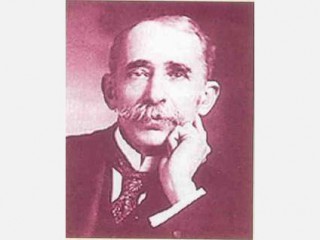
John Ambrose Fleming biography
Date of birth : 1849-11-29
Date of death : 1945-04-18
Birthplace : Lancaster, Lancashire, England
Nationality : British
Category : Arhitecture and Engineering
Last modified : 2010-06-04
Credited as : Electrical engineer, thermionic valve or vacuum tube, the diode
11 votes so far
The rectifying properties of the Fleming’s diode was certainly different from the ideal”single – way” electrical rectifier, but it was already sufficiently good for practical electronic applications.
Fleming was the author of more than a hundred scientific papers and books, including the influential”The Alternate Current Transformer” (1889, 1892),”The Principles of Electric Wave Telegraphy” (1906),”The Propagation of Electric Currents in Telephone and Telegraph Conductors” (1911) and”Memoirs of a Scientific Life” (1934).
Fleming’s rules: Rules to assist in remembering the relative directions of the field, current, and force in electrical machines. The left hand refers to motors, the right hand to generators. If the forefinger, second finger, and thumb of the left hand are extended at right angles to each other, the forefinger indicates the direction of the field, the second finger the direction of the current, and the thumb the direction of the force. If the right hand is used the digits indicate these directions in a generator. The mnemonic was invented by Sir John Ambrose Fleming.
Fleming remained at University College until 1926, retiring to the quiet town of Sidmouth in Devon. Two years after his retirement he was knighted for the many advances he had made to electrical and electronic engineering. During his retirement, Fleming still took an active interest in many new developments in the electronics world. For fifteen years he was president of the Television Society, often travelling to London for their meetings.
At the age of eighty-four he married for the second time. He also had many interests outside his work. He had a keen interest in photography and loved walking. He was also a devout Christian, and he often preached at various churches as well as once being asked to St Martin’s in the Fields. With his advancing age Fleming became increasingly deaf, however he remained active until his death in 1945 at the great age of 95. During his life he made achieved a tremendous amount, but it is certain that he will be chiefly remembered for the invention of the thermionic valve.
Books by Fleming
* Electric Lamps and Electric Lighting: A course of four lectures on electric illumination delivered at the Royal Institution of Great Britain (1894) 228 pages, ISBN 0548479377.
* The Alternate Current Transformer in Theory and Practice "The Electrician" Printing and Publishing Company (1896)
* Magnets and Electric Currents E. & F. N. Spon. (1898)
* A Handbook for the Electrical Laboratory and Testing Room "The Electrician" Printing and Publishing Company (1901)
* Waves and Ripples in Water, Air, and Aether MacMillan (1902).
* The Evidence of Things Not Seen Christian Knowledge Society: London (1904)
* The Principles of Electric Wave Telegraphy (1906), Longmans Green, London, 671 pages.
* The Propagation of Electric Currents in Telephone and Telegraph Conductors (1908) Constable, 316 pages.
* An Elementary Manual of Radiotelegraphy and Radiotelephony (1911) Longmans Green, London, 340 pages.
* On the power factor and conductivity of dielectrics when tested with alternating electric currents of telephonic frequency at various temperatures (1912) Gresham, 82 pages, ASIN: B0008CJBIC
* The Wonders of Wireless Telegraphy : Explained in simple terms for the non-technical reader Society for promoting Christian Knowledge (1913)
* The Wireless Telegraphist's Pocket Book of Notes, Formulae and Calculations The Wireless Press (1915)
* The Thermionic Valve and its Development in Radio Telegraphy and Telephony (1919).
* Fifty Years of Electricity The Wireless Press (1921)
* Electrons, Electric Waves and Wireless telephony The Wireless Press (1923)
* Introduction to Wireless Telegraphy and Telephony Sir Isaac Pitman and Sons Ltd. (1924)
* Mercury-arc Rectifiers and Mercury-vapour Lamps London. Pitman (1925)
* The Electrical Educator (3 volumes), The New Era Publishing Co Ltd (1927)
* Memories of a Scientific life Marshall, Morgan & Scott (1934)
* Evolution or Creation? (1938) Marshall Morgan and Scott, 114 pages, ASIN: B00089BL7Y - outlines objections to Darwin.
* Mathematics for Engineers George Newnes Ltd (1938)
















